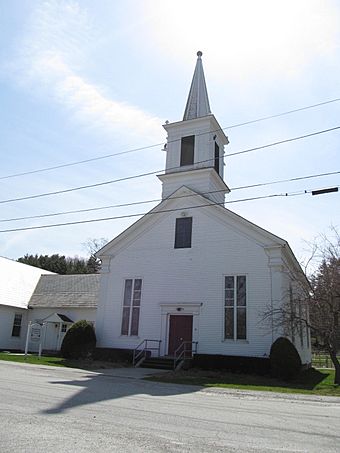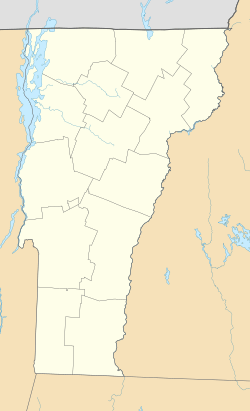East Arlington Village Historic District facts for kids
Quick facts for kids |
|
|
East Arlington Village Historic District
|
|
 |
|
| Location | Roughly bounded by Old Mill, Ice Pond, E. Arlington, and Warm Brook Rds., Maple and Pleasnt Sts., and the Lane, Arlington and Sunderland, Vermont |
|---|---|
| Area | 140 acres (57 ha) |
| Built | 1778 |
| Architectural style | Colonial Revival, Queen Anne, Greek Revival |
| NRHP reference No. | 96000689 |
| Added to NRHP | July 5, 1996 |
The East Arlington Village Historic District is a special area in Arlington and Sunderland, Vermont, Vermont. It's like a time capsule showing what a village looked like in the 1800s. This historic district is mainly found around Old Mill Road. It began as a mill village in the 1700s. In 1996, it was added to the National Register of Historic Places. This means it's an important place to protect because of its history.
Contents
Exploring East Arlington's History
East Arlington is located in the eastern part of Arlington, Vermont. This town is close to Vermont's border with New York. A small part of the district also goes into the nearby town of Sunderland. You can find it north of Vermont Route 313 and west of United States Route 7. Route 7 is a main road that runs north and south through western Vermont.
How East Arlington Started
People first settled in this village in the 1760s. This makes it one of the very first colonial settlements in Vermont. Early settlers were attracted to the area by the water power. Two streams, Peter's Branch and Warm Brook, provided power for local industries. These industries used water power until the early 1900s.
Village Growth and Changes
The village grew around its main roads. These include East Arlington Street, Ice Pond Road, Warm Brook Road, and Old Mill Road. Kansas Road also extends into Sunderland. The village was not on the main railroad line. The railroad ran to the west, near Arlington's central village. Also, the water power here was not as strong as in some other places. Because of this, industrial activity in East Arlington slowly declined.
However, in the early 1900s, the Hale Company expanded its operations. Parts of their old mill complex are still standing today.
What the Buildings Look Like
Most of the buildings in the historic district are in the Greek Revival style. This shows that the village grew a lot in the mid-1800s. You can also see older Federal style buildings. Later styles like Italianate and Queen Anne are also present. Many of these buildings have a simple, local design. Some have been changed over time with new siding added in the 1900s.
Unlike many old New England villages, East Arlington does not have a central common or open green space. There is only one church in the district. It is the Greek Revival Congregational Church, built between 1845 and 1848.



